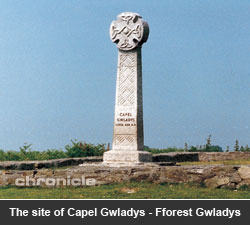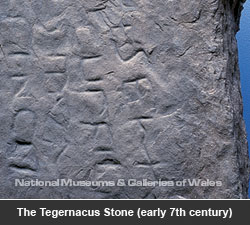
The Birth of Wales
The events that emerged from the embers of Roman rule are far from clear. It is likely that there was a struggle for power. This was probably between those that had previously held it under the Romans and those that now wanted it. Whatever happened, it appears that the unity brought by the Empire was soon shattered and from its pieces rose competing local kingdoms. In this new world the Roman towns seemed to fall from favour and new settlements were established in their place. These were often centred on the pre-Roman seats of power, such as the hillforts. This was also a period of great Christian activity and missionaries began to establish religious sites throughout the county borough, such as at Capel Gwladys, Fforest Gwladys.
The next six hundred years were turbulent times for many of the new Kingdoms. Danger and opportunity lay all around. One kingdom would conquer another, only then to be conquered itself and the new Kingdom in turn to crumble and collapse. There were also the Saxons, Danes and Irish - allies or enemies could be made of them all. Rulers and their warriors led violent lives as they constantly jockeyed for power. In 1043, a Welsh chronicle recorded that a King of Glamorgan had died of old age, this was a rarity and worthy of note.

Amidst this, Wales was arguably born. In A.D. 757 to 796 a great earthen dyke was built under the orders of the Anglo-Saxon king Offa. This was intended to run from Chepstow in the south to Prestatyn in the north. Although only eighty miles of this was built, it had the effect of creating a distinct new territory to the west and severing this from Britain. Those who lived in this new territory were described by the Anglo-Saxons as foreigners or 'Walas'. Hence, this new territory became known as Wales. In the mid-ninth century, the Kingdoms of Wales began to unite under the rule of a new breed of powerful kings. The second of these was Hywel Dda, who presided over the codification of Welsh Law in around A.D. 943. The last was Gruffydd ap Llywelyn and he was the only king to rule over the whole of Wales.
Against this backdrop the Kingdom of Glywyseg emerged in around the sixth century. This occupied the old territory of the Silures. Glywyseg appears to have been a reasonably stable kingdom and it avoided much of the turmoil of these times. By the eighth century Glywyseg had evolved into Morgannwg. This was divided into smaller administrative areas known as 'cantrefi' which in turn were divided into 'commotes'. Within the cantref of Senghenydd & Gwynllwg fell the modern county borough. The cantref of Senghenydd was divided into the commotes of Uwch Caiach, Is Caiach and finally Cibwr, which lay beyond the county borough. Each of these would have probably had its own court. Periodically the King of Morgannwg would visit these and be lavishly entertained by the local lord. At Uwch Caiach the court was probably at Gelligaer and at Is Caiach, at Caerphilly.
Image date: unknown
Location: unknown
Submitted by: unknown
Do you have any stories, images and interesting facts relating to this picture. Help Chronicle build a website of your Caerphilly County Borough memories. Email the webmaster telling us as much as you can about your pictures. Thank you
Description: